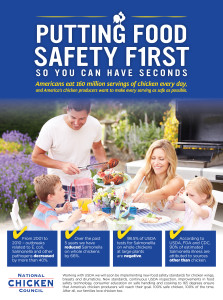The PBS documentary show “Frontline” aired a program on Tuesday night that explored 2011 and 2013 outbreaks related to ground turkey and chicken, respectively, and according to PBS, “examines why the standards and laws around salmonella have failed to keep up with the increasing danger posed by some strains of the bacteria.”
In response to the episode, NCC spokesman Tom Super said the following:
Americans eat about 160 million servings of nutritious chicken every day, and virtually all of them are eaten safely. But we understand consumers have concerns about Salmonella, and regret any instances when someone becomes ill from eating chicken products – which is why our members are investing heavily in food safety research and are using the best science, research and technology available to break the chain of Salmonella at every stage of production.
Since the fall of 2013, around the time of the events depicted in the Frontline episode, the entire chicken industry has been collectively exploring all options to reduce contamination on chicken parts in order to provide the safest product possible to our customers and their consumers, including strengthened sanitation programs, temperature controls and various interventions in chicken processing. This is something the industry has been proactively working to address, and we are committed to working with FSIS to make implementation of the performance standards for chicken parts a success for the industry, and most importantly, for consumers.
New standards, continuous USDA inspection, improvements in food safety technology, and consumer education on safe handling and cooking to 165F ensure that America’s chicken producers will reach our goal – 100 percent safe chicken, 100 percent of the time. After all, our families love chicken, too.
NCC this week ran ads on Capitol Hill. The following ad appeared Wednesday in Politico:
For questions and answers about Salmonella, chicken and the regulatory process, click here.
To read about what chicken producers are doing to reduce Salmonella, and for safe handling and cooking tips, click here.
An infographic about the industry’s food safety progress is available here.


